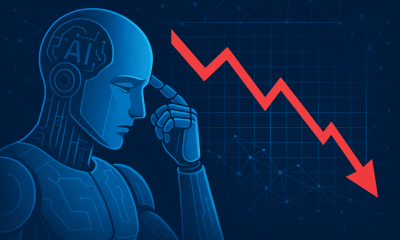Artificial Intelligence
AI’s New Gut Instinct: Why Thinking Smarter Matters More Than Thinking Longer

Advancements in artificial intelligence (AI) have long been driven by the belief that increasing data and computational power can improve performance. This “brute force” approach has led to impressive AI systems, such as GPT-3, which have performed remarkably well over the years. However, this paradigm is reaching its limits. As AI problems become more complex, it becomes clear that simply adding more processing power will not be a sustainable or effective solution for long-term progress. This realization has prompted researchers to rethink their approach to AI development. In this context, Deep Cogito's Cogito v2 model introduces a new approach that could change the future of AI development. Rather than depending on more processing power or extended reasoning, Cogito v2 develops internal “gut instincts” that guide the model to identify the right paths before even beginning the search. This is a paradigm shift in how AI is being developed by focusing on thinking better, not longer.
A Shift in AI Development
For many years, the driving force behind AI advancements was the idea that “more is better.” This approach has led to AI models that generate extensive reasoning chains to solve complex problems. OpenAI’s models, such as GPT-3, are an example of this approach, where longer thinking chains have led to impressive results on difficult tasks. While this method has produced impressive results, it comes with significant drawbacks. Longer reasoning chains require more computational resources which results in slower inference times and higher operational costs. Moreover, research has shown that these extended processes often lead to diminishing returns, where longer reasoning leads to greater bias and less efficiency. The fundamental issue is that relying on long reasoning chains and increasing computational power is no longer an effective solution for tackling complex AI problems. These approaches are limited by their massive processing time and memory requirements.
Why ‘Gut Instinct' Matters to AI
Unlike current AI systems that depend on extended reasoning, humans often rely on what is called “gut instinct” (a form of quick, intuitive judgment) to solve problems. While gut instinct may seem like an abstract concept, it is often the result of years of experience, learning, and context processing that allows humans to make quick decisions without fully analyzing every detail. It’s this type of intuition that separates raw computation from human-like reasoning. Humans build this ‘gut instinct’ through pattern recognition and accumulated experience and it enables us to make decisions without exhaustively exploring every possible option. AI's new “gut instinct” aims to replicate this process.
This idea, also referred to as the “intelligence prior”, could be a key to empowering AI systems with human-like reasoning and making them more efficient. AI models with strong intelligence prior can anticipate which solutions are likely to succeed without having to go through extensive computation. Instead of relying on exhaustive search methods, gut instinct allows AI systems to leverage previous knowledge, focusing on the most effective paths to a solution.
How Cogito v2 Incorporated ‘Gut Instinct'
Cogito has incorporated the idea of ‘gut instinct’ (more technically, intelligence prior) into its recently released model Cogito v2. They integrated this idea using a mechanism called Iterated Distillation and Amplification (IDA). This mechanism enables the model to learn from its own reasoning process and refine its problem-solving skills over time. Instead of relying on static prompts or fixed teachers, IDA enables the AI to distill successful reasoning paths back into its core model parameters. This self-improvement process refines the model’s reasoning ability over time, optimizing not just for accurate answers, but for the most efficient methods of thinking.
-
Iterated Distillation and Amplification (IDA)
To understand how IDA works, we can look at dual-process theory, which divides human thinking into two systems: System 1 and System 2. System 1 refers to quick, intuitive decision-making, while System 2 is slower, with more deliberate reasoning. The theory suggests that humans rely on System 1 for most tasks but switch to System 2 when faced with more complex decisions.
IDA is a two-step cycle: amplification and distillation. In the amplification phase, the model uses intensive computational methods to generate high-quality solutions or reasoning traces. This is like System 2 thinking, where the AI takes the time to carefully evaluate potential solutions. In the distillation phase, the model then internalizes the insights from the amplification phase, transforming the reasoning process from System 2 to System 1. Just as a human driver becomes more intuitive after gaining experience, an AI model with IDA can make faster, more efficient decisions over time.
The key idea behind IDA is to use computationally intensive reasoning in the amplification phase, then distill the enhanced reasoning back into the model’s parameters. This process allows the model to internalize effective reasoning strategies that builds its capacity to think intuitively when solving problem. By repeating this cycle, the AI system continually improves its ability to make decisions with fewer computational resources.
Advantages of Integrating ‘Gut Instinct' into AI
One of the main advantages of AI's gut instinct is its efficiency. Models like Cogito v2 demonstrate reasoning chains that are up to 60% shorter than those of competing models. This means that they can arrive at answers with fewer internal steps, reducing the time and resources required for inference. For example, a problem that might take DeepSeek R1 over 200 tokens to solve can be completed by Cogito v2 in fewer than 100 tokens.
Moreover, the cost of training Cogito v2 is significantly lower than that of traditional AI models. The entire training process for Cogito v2, covering a wide range of parameters, cost under $3.5 million which is far less than the expenses typically associated with large-scale models like GPT-4.
Cogito v2 has also demonstrated emergent abilities in areas it wasn’t explicitly trained for. For example, despite being trained primarily on text, Cogito v2 can reason about images, drawing insights about image composition and habitats. This cross-modal reasoning capability is a significant step towards generalized intelligence, an important milestone on the path to Artificial General Intelligence (AGI).
Rethinking AI Development
The success of intelligence prior suggests that AI development strategies need a fundamental shift. Rather than simply scaling up model size or increasing computational resources, AI development should focus on building systems that can develop and refine their own cognitive strategies. This shift mirrors human cognitive development, where intelligence is not a result of a bigger brain or more thinking time, but rather better mental models and reasoning strategies. This change in approach could have long-term implications. By emphasizing smarter reasoning over raw compute power, AI can become more versatile, adaptable, and capable of handling new challenges. This shift could accelerate AI’s application in industries such as healthcare, cybersecurity, and autonomous transportation, making AI systems more efficient, cost-effective, and impactful.
The Bottom Line
The success of Cogito v2 demonstrates that the future of AI lies not in scaling up models or increasing computational power, but in refining reasoning architectures and optimizing for smarter problem-solving. This shift promises a more sustainable and accessible future for AI, where systems can continuously improve and adapt with less reliance on vast computational resources. By focusing on intelligent reasoning rather than brute-force computation, AI can become more capable of tackling complex, real-world problems.












